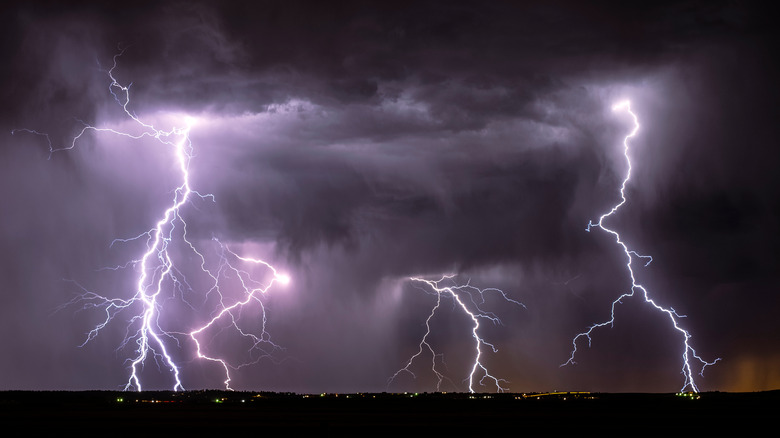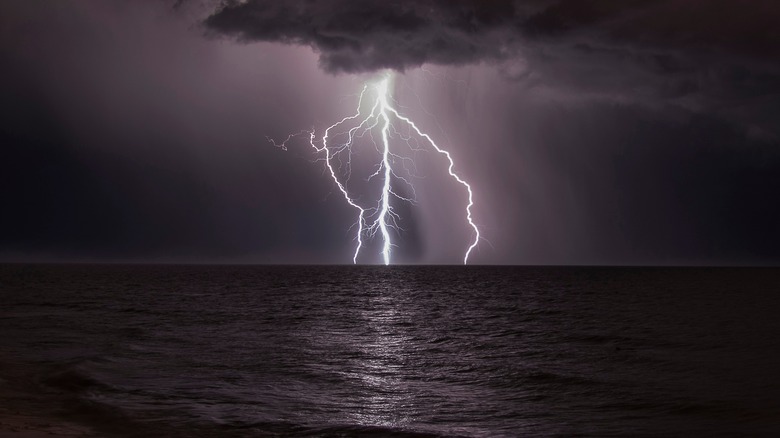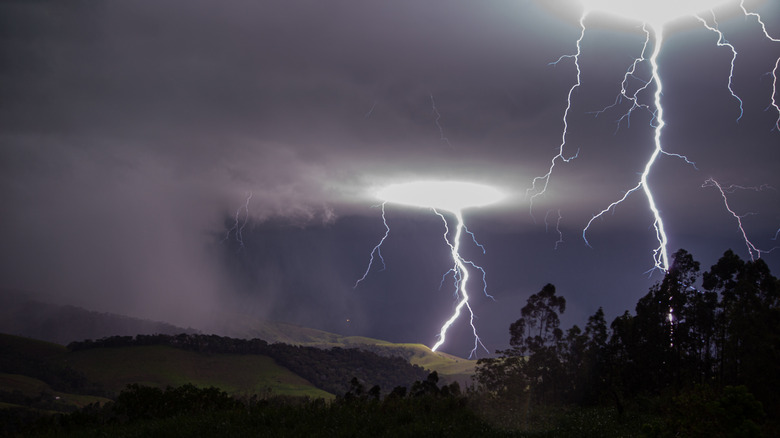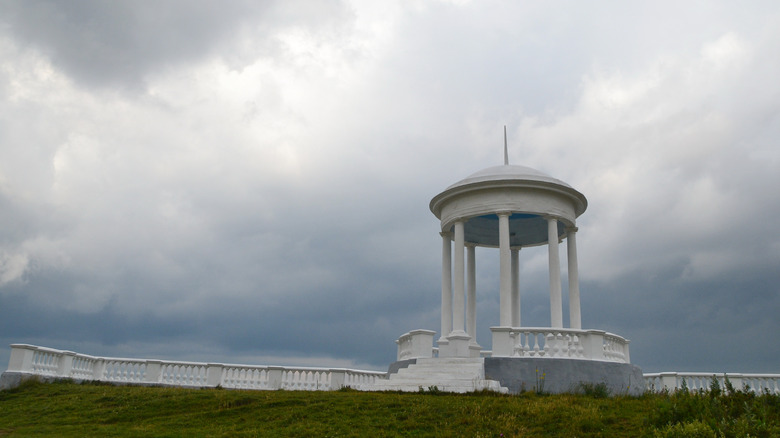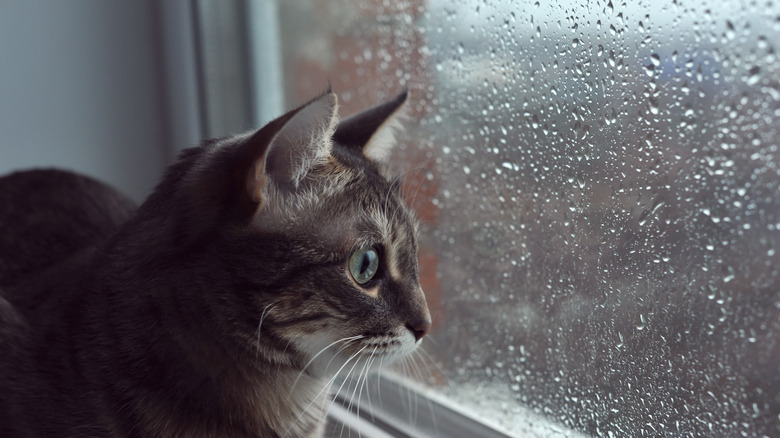The 10 Places You Should Never Shelter During A Thunderstorm
Some of nature's most beautiful moments are also its most formidable. When a thunderstorm roars to life, many enjoy grabbing themselves a warm drink and watching it from the safety and comfort of their own home. According to the National Weather Service, there are up to 40 thousand thunderstorms every day around the world. In the United States, the most active spot for storms is the southeastern states where the warm air from the Gulf of Mexico and the Atlantic Ocean creates the perfect conditions for such weather.
There are five different types of thunderstorms: The Ordinary Cell, Multi-cell Cluster, Multi-cell Line or Squall Line, and the Supercell Thunderstorms, all of which have different characteristics per the National Weather Service. While thunderstorms are generally beautiful with their flashing lights and ominous yet pleasant skies, no place outdoors is ever safe during one of these events. "When thunder roars, go indoors" is more than just a saying; it's a reminder of how the dangers of these storms can be minimized. However, whether indoors or outdoors, there are a few places that should never be considered safe shelters during a thunderstorm.
Whether inside or outside, water isn't safe during a thunderstorm
First and foremost, if you are outside when a thunderstorm rolls in and you happen to be near a body of water, get away from it immediately. Second, if you are inside during a thunderstorm, stay away from water. Contact with water should be minimized or avoided entirely while waiting out a storm. This includes baths, showers, doing the dishes, or anything else that may involve water, as lightning can travel through the plumbing system, according to an article published on the Centers for Disease Control and Prevention's (CDC) website.
Water isn't the only danger indoors, either. Electrical outlets pose their own problems as lighting can travel through metal wires or bars. The best thing to do if you find yourself inside during a storm is to steer clear of windows, doors, porches, and water, per the CDC website. Someone wanting to watch the storm unfold outside while remaining warm and cozy inside would be better off viewing it a reasonable distance from their windows.
Avoid elevated areas and objects that conduct electricity
When looking for the perfect place to wait out a thunderstorm, it's necessary to avoid being high up. Areas including hilltops, mountain ridges, or peaks should be avoided at all costs, and if you find yourself already on one, then getting to a lower area should be a priority per the CDC. While avoiding too much elevation is necessary, you don't want to relax too much once you've found shelter outdoors either; laying flat on the ground can be dangerous during storms.
An outdoor shelter should be away from objects that conduct electricity. This can be anything from metal fences, powerlines, or even other humans. That's correct: During a thunderstorm, if you're near a large group of people, it's best to separate from one another as this will mitigate the number of injuries that may occur should lighting strike the ground close by. Ideally, though, a group of people should find shelter in an enclosed structure with plumbing and electricity. The pipes and the wiring throughout the building will conduct electricity better than humans, according to Weather.gov.
Different landscapes call for different sheltering tactics
When the sky starts getting dark and the first raindrops begin to fall, it may seem like the best plan to take shelter in any location that will keep you dry. Unfortunately, this isn't the case, especially in the outdoors, where you run the risk of getting caught up in the storm's full chaos. An isolated tree should never be used as a shelter, though. However, if you find yourself in a situation where you're surrounded by trees and plant life, sheltering by the ones closest to the ground is best, according to the CDC.
Cliffs or rocky overhangs should be avoided and not used as shelters. Whether caused by lightning, or something falling on them, the structure might not be sound and could injure a person taking cover underneath. Likewise, any place near a body of water, like a river, pond, or creek, should always be avoided. If you've scouted a shelter near a body of water, find a different one right away.
Partial shelters don't count as being indoors
The difference between an indoor and an outdoor shelter might seem straightforward as far as which is which, but there's a type of shelter that fits into neither category and can play a big part in a person's safety during a thunderstorm. Partial shelters are not safe places during thunderstorms. They might keep someone dry from the rain but dry doesn't always equal safe. Partial shelters include places like playgrounds, gazebos, convertible cars, and patios. All of these areas should be avoided, per the CDC.
Lightning itself typically strikes the tallest object in the area. This includes telephone poles and any isolated trees or statues. This is why it's crucial to stay away from open spaces like meadows or golf courses where, if you're alone, or the tallest one around, you may be facing serious trouble. According to the National Weather Service, the odds of someone being struck by lightning in their lifetime is 1 in 15,300. Following safety guidelines during a thunderstorm will help keep those odds as low as possible.
You can still enjoy watching thunderstorms, just do so safely
There are a lot of ways to enjoy the beauty of a thunderstorm while also staying as safe as possible. When inside, stay in an interior room away from doors and windows as much as possible, and do so for at least thirty minutes after the storm has ended. According to Weather.gov, most people who have been struck by lightning were struck before or after the height of the storm, as lighting can strike up to ten miles from the area where it's actually raining. This means that just because the storm seems over where you're at doesn't mean it is.
If you see lighting and want to know how close it is to your location, count the seconds until you hear the thunder that follows it. Then divide the number of seconds by five. What you're left with is the distance the lighting is away from you. Weather.gov calls this the "Flash to Bang" method, which is a great way to know just how quickly you should be seeking shelter from the impending thunderstorm while keeping in mind which places will actually keep you safe.
